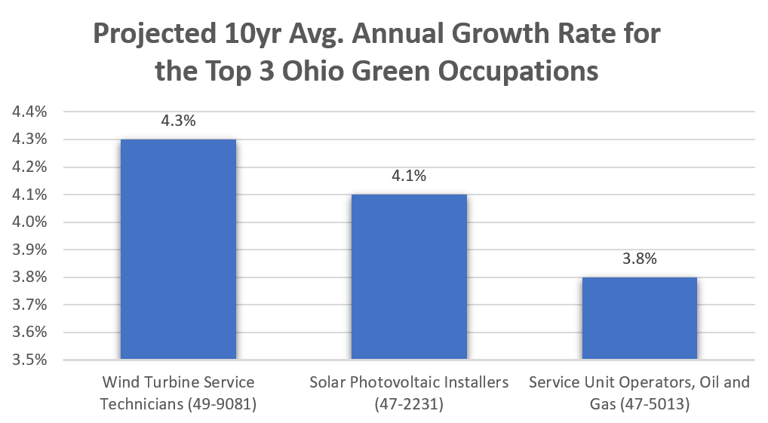New Green Occupations for JobsEQ

By Jonathan Cox |
As the urgency to combat climate change increased globally, there has been an effort to change how businesses produce goods and services. This has promoted what is called the “Green Economy.” The prominence of the Green Economy has grown significantly over the past decade as governments around the world have passed new laws and regulations to battle climate change.
Recognizing the growing influence of the Green Economy in the United States, Chmura added two searchable occupation groups in JobsEQ® to capture “green jobs.” This blog is a description of how these groups were defined and how they can be used for analysis.
Defining Green Jobs
Our definition of green jobs primarily relies upon a 2011 study published by O*NET titled “Greening of the World of Work: Revisiting Occupational Consequences.”[i] This study used a concept called “occupational greening” which examines how the Green Economy impacts or redefines the duties and responsibilities of occupations—which are defined by SOC codes. Thus, this study used an occupation-centric approach to define green jobs.
However, we acknowledge that there is no one standard method for defining green jobs. In fact, the Bureau of Labor Statistics[ii] has previously used a more industry-focused approach. They measured green jobs as all jobs in establishments that produced green goods and services or used environmentally friendly production processes.
Regardless, while there are multiple approaches to defining green jobs, the approach we used in JobsEQ is occupation-focused.
The 2011 O*NET Green Jobs Study
The O*NET study defined the Green Economy as “economic activity related to reducing the use of fossil fuels, decreasing pollution and greenhouse gas emissions, increasing the efficiency of energy usage, recycling materials, and developing and adopting renewable sources of energy.”
Using this definition, the authors divided the Green Economy into 12 different sectors:[iii]
- Renewable Energy Generation
- Transportation
- Energy Efficiency
- Green Construction
- Energy Trading
- Energy and Carbon Capture and Storage
- Research, Design, and Consulting Services
- Environment Protection
- Agriculture and Forestry
- Manufacturing
- Recycling and Waste Reduction
- Governmental and Regulatory Administration
Within each sector, the impact of the Green Economy on an occupation was measured in one of three ways:
- Green Increased-Demand Occupations. Here the impact of the Green Economy caused an increase in the demand for an existing occupation but did not change the existing tasks and duties of that occupation. For example, bus drivers (SOC 53-3021.00) were classified as a green increased-demand occupation. One reason why the demand for bus drivers might increase is because increasing the availability of public transit is a great way to reduce fossil fuel emissions. Subsequently, increasing the availability of public transit will require cities to hire more bus drivers.
- Green Enhanced-Skills Occupations. These are occupations where the Green Economy has spurred a significant change in the tasks, skill, or credentials of an existing occupation. Electrical engineers (SOC 17-2071.00) are a great example. One of the new green tasks of electrical engineers is designing electrical systems or components that minimize electric energy requirements. This could take the form of designing lighting systems that account for natural lighting.
- Green New and Emerging Occupations. Here the impact of the Green Economy is so strong that an entirely new SOC code was created to capture new green work/tasks. Two examples of occupations that fall into this category are wind turbine service technicians (SOC 49-9081.00) and water/wastewater engineers (SOC 17-2081.01).
The occupations in those twelve sectors that were impacted in one of the three ways above were classified as green jobs. A full list of the SOCs that were classified as green jobs and their connection to the Green Economy can be found in the appendix of the O*NET study.
The Process We Used to Incorporate Green Occupations in JobsEQ
The occupations that were identified as green jobs in the O*NET study were 8-digit 2010 SOC codes. However, since the study’s publication in 2011, a new version of SOC codes have been released: the 2018 SOC codes. Thus, our first step was to crosswalk the 2010 SOC codes from the study to the 2018 SOC codes.
Next, it was necessary to crosswalk the 8-digit 2018 SOCs to the 6-digit 2018-hybrid SOCs.[iv] The reason why it was necessary to crosswalk from the 8-digit SOC level to the 6-digit SOC level is because most publicly available occupation data (such as employment and wages) is published at the 6-digit level, including most of the occupation data in JobsEQ. The reason for using 2018-hybrid SOC codes is a temporary situation due to the Occupational Employment Statistics Survey as discussed in greater detail in one our other blogposts.
Using the Green Job Occupations Groups in JobsEQ®
In JobsEQ, you can find information for the two green jobs occupation groups we added in any occupation-based analytic. The first group is called “Green Jobs – Total” and includes all the jobs identified in the above process. The second group is called “Green Jobs – requiring HS or less” and is a subset of the first group, including only those green jobs which typically do not require more than a high-school education for entry—a group designed especially to help workforce development professionals place job-seekers without a college background in the green economy.

As some example JobsEQ queries, the group of green jobs can be examined for regional growth prospects—the above chart, for example, shows the three green jobs with the fastest expected growth in Ohio. After identifying which green jobs are growing the fastest, you could then use the completions data in JobsEQ to identify whether your region’s talent pipeline can support the growing demand for those occupations—for example, if schools in your region are graduating students with degrees in programs that are associated with wind turbine service technicians or other green jobs.
JobsEQ also houses online profile/resume data, allowing you to view the characteristics of people that are already working in an occupation in your region, such as their educational background and credentials. For example, in Ohio, I can see that the majority of people currently working as wind turbine service technicians do not have a bachelor’s degree listed on their resume.
Next, you could use our RTI data (online job-postings) to understand the regional demand for green jobs in your region. RTI allows you to view real-time jobs postings from employers in your region. Thus, you can see which employers are posting jobs and what skills/credentials they are demanding of applicants and at what wage. In Ohio, the employer who posted the most 2019 job ads for wind turbine service technicians was FieldCore, a subsidiary of General Electric. The same RTI data show for wind turbine service technicians a highly requested applicant requirement was to have experience with generators.
As you can see, there are many tools in JobsEQ that can help you understand the impact of the Green Economy on your region and help prepare your community for the future.
[i] Dierdorff, Erich, Jennifer J. Norton, Christina M. Gregory, David Rivkin, Phil Lewis. “Greening of the World of Work: Revisiting Occupational Consequences.” https://www.onetcenter.org/reports/Green2.html
[ii] Bureau of Labor Statistics. “Measuring Green Jobs.” https://www.bls.gov/green/home.htm
[iii] A detailed definition of each sector can be found on page 11 of “Greening of the World of Work: Revisiting Occupational Consequences.”
[iv] A 6-digit SOC code can be comprised of multiple 8-digit SOCs, and some of the 8-digit components may be identified as green jobs while others are not. We determined that if 20% or more of the 2019 job ads in our RTI Job Posting Database for a 2018 6-digit hybrid SOC had come from 8-digit SOCs identified as green jobs, then that 6-digit SOC would be included in our green job definition. Most of the 6-digit SOCs in the analysis were well above the 20% threshold. To see which SOCs did not pass the 20% hurdle and thus were not included in our JobsEQ green jobs definition, view Slide 40 of “The Greening of the Economy: The Future of Green Jobs” webinar.
Subscribe to the Weekly Economic Update
Subscribe to the Weekly Economic Update and get news delivered straight to your inbox.











